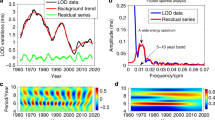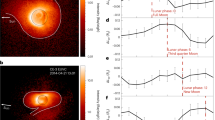Abstract
It is a long-standing puzzle that the Sun's photosphere—its visible surface—rotates differentially, with the equatorial regions rotating faster than the poles. It has been suggested1 that waves analogous to terrestrial Rossby waves, and known as r-mode oscillations, could explain the Sun's differential rotation: Rossby waves are seen2 in the oceans as large-scale (hundreds of kilometres) variations of sea-surface height (5-cm-high waves), which propagate slowly either east or west (they could take tens of years to cross the Pacific Ocean). Calculations show that the solar r-mode oscillations have properties that should be strongly constrained by differential rotation3. Here we report the detection of 100-m-high ‘hills’ in the photosphere, spaced uniformly over the Sun's surface with a spacing of (8.7 ± 0.6) × 104 km. If convection under the photosphere is organized by the r-modes, the observed corrugated photosphere is a probable surface manifestation of these solar oscillations.
This is a preview of subscription content, access via your institution
Access options
Subscribe to this journal
Receive 51 print issues and online access
$199.00 per year
only $3.90 per issue
Buy this article
- Purchase on Springer Link
- Instant access to full article PDF
Prices may be subject to local taxes which are calculated during checkout





Similar content being viewed by others
References
Plaskett, H. H. The polar rotation of the Sun. Mon. Not. R. Astron. Soc. 131, 407–433 (1966).
Chelton, D. B. & Schlax, M. G. Global observations of oceanic Rossby waves. Science 272, 234–238 (1996).
Wolff, C. L. Linear r-mode oscillations in a differentially rotating star. Astrophys. J. 502, 961–967 (1998).
Papaloizou, J. & Pringle, J. E. Non-radial oscillations of rotating stars and their relevance to the short-period oscillations of cataclysmic variables. Mon. Not. R. Astron. Soc. 182, 423–442 (1978).
Kumar, P., Quataert, E. & Bahcall, J. Observational searches for solar g-modes: some theoretical considerations. Astrophys. J. 458, 83–L85 (1996).
Provost, J., Berthomeiu, G. & Rocca, A. Low frequency oscillations of a slowly rotating star—quasi toroidal modes. Astron. Astrophys. 94, 126–133 (1981).
Wolff, C. L. & Blizard, J. B. Properties of r-modes in the Sun. Sol. Phys. 105, 1–15 (1986).
Kuhn, J. R., Bush, R., Scheick, X. & Scherrer, P. The Sun's shape and brightness. Nature 392, 155–157 (1998).
Lazrek, M. et al. First results on p-modes from GOLF experiment. Sol. Phys. 175, 227–246 (1997).
Scherrer, P. H. et al. The solar oscillations investigation—Michelson Doppler Imager. Sol. Phys. 162, 129–188 (1995).
Schrijver, C. J., Hagenaar, H. R. & Title, A. M. On the patterns of the solar granulation and supergranulation. Astrophys. J. 475, 328–337 (1997).
Rice, S. O. Mathematical analysis of random noise. Bell Syst. Tech. J. 23, 1–162 (1944).
Wolff, C. L. Distinctive patterns on the surface of slowly rotating stars whose oscillations are non-linearly coupled. Astrophys. J. 193, 721–727 (1974).
Wolff, C. Oscillation convection coupling: cause of supergranulation. Astrophys. J. 443, 423–433 (1995).
Acknowledgements
We thank J. Saba, C. DeForest and J. Covington for assistance in operating the MDI instrument during these observations. We are particularly grateful to R. Bogart and to X. Scheick for their help with the limb software analysis.
Author information
Authors and Affiliations
Corresponding author
Rights and permissions
About this article
Cite this article
Kuhn, J., Armstrong, J., Bush, R. et al. Rossby waves on the Sun as revealed by solar ‘hills’. Nature 405, 544–546 (2000). https://doi.org/10.1038/35014530
Received:
Accepted:
Issue Date:
DOI: https://doi.org/10.1038/35014530
This article is cited by
-
Rossby Waves in Astrophysics
Space Science Reviews (2021)
-
The Sun’s supergranulation
Living Reviews in Solar Physics (2018)
-
The detection of Rossby-like waves on the Sun
Nature Astronomy (2017)
-
Influence of the Solar Global Magnetic-Field Structure Evolution on CMEs
Solar Physics (2014)
-
Periodicities of Sunspot Number and Coronal Index Time Series During Solar Cycle 23
Solar Physics (2011)
Comments
By submitting a comment you agree to abide by our Terms and Community Guidelines. If you find something abusive or that does not comply with our terms or guidelines please flag it as inappropriate.



